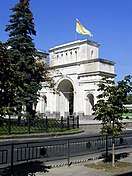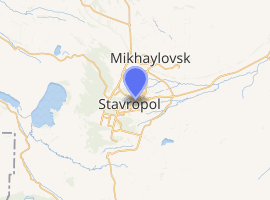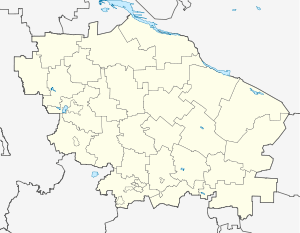Stavropol
Stavropol (/stævˈroʊpəl/, Russian: Ставрополь, IPA: [ˈstavrəpəlʲ]) a city and the administrative center of Stavropol Krai, Russia. As of the 2010 Census, its population was 398,539.[7]
Stavropol Ставрополь | |
|---|---|
City[1] | |
.jpg)   | |
 Flag .png) Coat of arms | |
| Anthem: none[2] | |
Location of Stavropol 
| |
 Stavropol Location of Stavropol  Stavropol Stavropol (Stavropol Krai) | |
| Coordinates: 45°03′N 41°59′E | |
| Country | Russia |
| Federal subject | Stavropol Krai[3] |
| Founded | October 22, 1777[4] |
| City status since | 1785[5] |
| Government | |
| • Body | City Duma[6] |
| • Head[6] | Ivan Ulyanchenko |
| Elevation | 620 m (2,030 ft) |
| Population | |
| • Total | 398,539 |
| • Estimate (2018)[8] | 433,931 (+8.9%) |
| • Rank | 47th in 2010 |
| • Subordinated to | city of krai significance of Stavropol[1] |
| • Capital of | Stavropol Krai[3], city of krai significance of Stavropol[1] |
| • Urban okrug | Stavropol Urban Okrug[9] |
| • Capital of | Stavropol Urban Okrug[9] |
| Time zone | UTC+3 (MSK |
| Postal code(s)[11] | 355000–355013, 355016–355021, 355024–355026, 355028–355032, 355035, 355037, 355038, 355040–355042, 355044, 355045, 355047 |
| Dialing code(s) | +7 8652 |
| OKTMO ID | 07701000001 |
| Website | ставрополь |
It was previously known as Voroshilovsk (until January 12, 1943).[12]
Etymology
The name Stavropol (Russian: Ста́врополь) is a Russian rendering of the Greek name, Stauropolis (Greek: Σταυρούπολις 'City of the Cross'. According to legend, soldiers found a stone cross there while building the fortress in the city's future location.[13] It is unrelated to Byzantine Stauroupolis (ancient Aphrodisias) in Asia Minor, nor to the city of Stavropol-on-Volga (now called Tolyatti).
History
It was founded on October 22, 1777[4] following the Russo-Turkish War of 1768–1774 as a military encampment,[13] and was granted city status in 1785.[5] Prince Grigory Potemkin, who founded Stavropol as one of ten fortresses built between Azov and Mozdok at the request of Catherine the Great, played a leading role in the creation of the city. Don Cossacks, particularly those from the Khopersky Regiment, settled the area in and around the cities of Stavropol and Georgiyevsk with a mission to defend borders of the Empire.[14]
Alexander I in 1809 invited several Armenian families to settle by the fortress, in order to encourage trade in the region.
Stavropol's strategic location aided in the Russian Empire's conquest of the Caucasus. By the early 19th century the city grew into a busy trade center of the North Caucasus. In 1843, an Episcopal see of the Russian Orthodox Church was established in Stavropol and in 1847 the city became the seat of Stavropol Governorate.[15]
During the Russian Civil War the city changed hands several times and finally was captured by the Red Army from the Volunteer Army of general Anton Denikin on January 29, 1920. The city was renamed Voroshilovsk on May 5, 1935, after Kliment Voroshilov, but the original name was restored in 1943. The Great Patriotic War took a heavy toll on the city and between August 3, 1942 and January 21, 1943 Stavropol was occupied by the Germans and its airport was used as a base for the Luftwaffe (German air force) to bomb Soviet oil supplies in Grozny. The city was recaptured by the Soviet Army in January, 1943. Since 1946, natural gas has been extracted near the city; later on, a pipeline to supply Moscow was built.
Administrative and municipal status
Stavropol is the administrative center of the krai.[3] Within the framework of administrative divisions, it is, together with one rural locality (the khutor of Grushevy), incorporated as the city of krai significance of Stavropol—an administrative unit with the status equal to that of the districts.[1] As a municipal division, the city of krai significance of Stavropol is incorporated as Stavropol Urban Okrug.[9]
Economy
Stavropol's economy focuses on the production of automobiles, furniture, and construction equipment and materials. The city relies on air transport (Shpakovskoye airport), rail, and highway connections to other Russian cities.
Demographics
| 2010 Census | 398,539[7] |
|---|---|
| 2002 Census | 354,867[16] |
| 1989 Census | 318,298[17] |
| 1979 Census | 258,233[18] |
Stavropol's population includes a significant number of refugees escaping the strife or instability of the Russian border regions and Caucasus nations to the south.
Facilities
Stavropol has a theater and an association football team called FC Dynamo Stavropol.
The main educational institutions of the town include North-Caucasus Federal University, Stavropol State Agrarian University, and Stavropol State Medical University.
The area of Russia in which Stavropol resides is very mountainous, placing the city in the midst of the northern Caucasus mountain range. The city has one of the biggest city parks in Russia, 'Victory Park' covering up to 200 hectares.[19]
The city, like many other Russian cities has its own botanical garden, which covers up to 18 hectares, including 16 hectares of natural woods.[13][20]
Climate
Stavropol experiences a humid subtropical climate (Köppen climate classification: Cfa), bordering an oceanic climate (Cfb) or, following the 0 °C isotherm, a humid continental climate (Dfa/Dfb), with short but cold winters (though mild for Russia) and hot summers. Precipitation is rather low, with a 562 millimeters (22.1 in) annual average.
Stavropol is not protected by the mountains in the winter months, so it can frequently get very cold. The lowest temperature recorded in Stavropol was −28.3 °C (−18.9 °F) on 8 February 2012, while the highest was +39.7 °C (103.5 °F) on 8 August 2006.
| Climate data for Stavropol | |||||||||||||
|---|---|---|---|---|---|---|---|---|---|---|---|---|---|
| Month | Jan | Feb | Mar | Apr | May | Jun | Jul | Aug | Sep | Oct | Nov | Dec | Year |
| Record high °C (°F) | 16.7 (62.1) |
20.9 (69.6) |
30.2 (86.4) |
35.0 (95.0) |
32.5 (90.5) |
36.3 (97.3) |
38.6 (101.5) |
39.7 (103.5) |
37.3 (99.1) |
34.2 (93.6) |
24.8 (76.6) |
21.9 (71.4) |
39.7 (103.5) |
| Average high °C (°F) | 1.2 (34.2) |
1.7 (35.1) |
7.3 (45.1) |
15.5 (59.9) |
20.5 (68.9) |
24.9 (76.8) |
28.2 (82.8) |
28.0 (82.4) |
22.4 (72.3) |
15.3 (59.5) |
7.5 (45.5) |
2.9 (37.2) |
14.6 (58.3) |
| Daily mean °C (°F) | −2.3 (27.9) |
−2.3 (27.9) |
2.3 (36.1) |
9.6 (49.3) |
14.8 (58.6) |
19.2 (66.6) |
22.3 (72.1) |
21.8 (71.2) |
16.4 (61.5) |
10.0 (50.0) |
3.4 (38.1) |
−0.7 (30.7) |
9.5 (49.1) |
| Average low °C (°F) | −5.1 (22.8) |
−5.3 (22.5) |
−1.1 (30.0) |
5.1 (41.2) |
10.0 (50.0) |
14.5 (58.1) |
17.1 (62.8) |
16.5 (61.7) |
11.8 (53.2) |
6.3 (43.3) |
0.5 (32.9) |
−3.5 (25.7) |
5.6 (42.1) |
| Record low °C (°F) | −27.7 (−17.9) |
−28.3 (−18.9) |
−19.4 (−2.9) |
−10.7 (12.7) |
−2.3 (27.9) |
3.1 (37.6) |
8.5 (47.3) |
6.0 (42.8) |
−3.5 (25.7) |
−12.0 (10.4) |
−19.9 (−3.8) |
−24.3 (−11.7) |
−28.3 (−18.9) |
| Average precipitation mm (inches) | 29 (1.1) |
28 (1.1) |
35 (1.4) |
45 (1.8) |
66 (2.6) |
83 (3.3) |
58 (2.3) |
43 (1.7) |
47 (1.9) |
49 (1.9) |
46 (1.8) |
33 (1.3) |
562 (22.1) |
| Average rainy days | 5 | 5 | 8 | 13 | 13 | 13 | 10 | 8 | 10 | 11 | 10 | 7 | 113 |
| Average snowy days | 13 | 13 | 9 | 1 | 0.3 | 0 | 0 | 0 | 0 | 1 | 6 | 10 | 53 |
| Average relative humidity (%) | 84 | 82 | 78 | 68 | 68 | 66 | 60 | 60 | 68 | 77 | 84 | 84 | 73 |
| Source: Pogoda.ru.net[21] | |||||||||||||
Notable people
Well-known Russians who have visited or resided in Stavropol include: Generals Alexander Suvorov, Alexey Yermolov, and Nikolay Raevsky, the poets Alexander Pushkin and Mikhail Lermontov, who were in political disfavor, the surgeon Nikolay Pirogov, Alexander Griboyedov, Leo Tolstoy, and the national poet of Ossetia, Kosta Khetagurov.[22]
The first and only executive president of the Soviet Union, Mikhail Gorbachev, was born in Stavropol Krai and spent several years working in the city of Stavropol as the head of the krai's administration. Gorbachev's chief mentor, long-time friend, and predecessor Yuri Andropov was also born in Stavropol Krai.
Actor Lev Gorn (The Americans) was born in Stavropol.
Twin towns – sister cities
Stavropol is twinned with:[23]






References
Notes
- Resolution #63-p
- Article 3 of the Charter of Stavropol states that the city may have an anthem, providing a law is adopted to that effect. As of 2015, no such law is in place. The Symbols section on the Stavropal's official website also does not include an anthem.
- Law #9-kz
- Charter of Stavropol, Article 2
- Энциклопедия Города России. Moscow: Большая Российская Энциклопедия. 2003. p. 438. ISBN 5-7107-7399-9.
- Charter of Stavropol, Article 30
- Russian Federal State Statistics Service (2011). "Всероссийская перепись населения 2010 года. Том 1" [2010 All-Russian Population Census, vol. 1]. Всероссийская перепись населения 2010 года [2010 All-Russia Population Census] (in Russian). Federal State Statistics Service.
- http://www.gks.ru/free_doc/doc_2018/bul_dr/mun_obr2018.rar; archive date: 26 July 2018; retrieved: 25 July 2018; archive URL: https://web.archive.org/web/20180726010024/http://www.gks.ru/free_doc/doc_2018/bul_dr/mun_obr2018.rar.
- Law #88-kz
- "Об исчислении времени". Официальный интернет-портал правовой информации (in Russian). June 3, 2011. Retrieved January 19, 2019.
- Почта России. Информационно-вычислительный центр ОАСУ РПО. (Russian Post). Поиск объектов почтовой связи (Postal Objects Search) (in Russian)
- Decree of January 12, 1943
- "Stavropol". stavmed.com. Retrieved October 12, 2015.
- "Archived copy". Archived from the original on February 17, 2007. Retrieved January 13, 2008.CS1 maint: archived copy as title (link)
- Russian Federal State Statistics Service (May 21, 2004). "Численность населения России, субъектов Российской Федерации в составе федеральных округов, районов, городских поселений, сельских населённых пунктов – районных центров и сельских населённых пунктов с населением 3 тысячи и более человек" [Population of Russia, Its Federal Districts, Federal Subjects, Districts, Urban Localities, Rural Localities—Administrative Centers, and Rural Localities with Population of Over 3,000] (XLS). Всероссийская перепись населения 2002 года [All-Russia Population Census of 2002] (in Russian).
- "Всесоюзная перепись населения 1989 г. Численность наличного населения союзных и автономных республик, автономных областей и округов, краёв, областей, районов, городских поселений и сёл-райцентров" [All Union Population Census of 1989: Present Population of Union and Autonomous Republics, Autonomous Oblasts and Okrugs, Krais, Oblasts, Districts, Urban Settlements, and Villages Serving as District Administrative Centers]. Всесоюзная перепись населения 1989 года [All-Union Population Census of 1989] (in Russian). Институт демографии Национального исследовательского университета: Высшая школа экономики [Institute of Demography at the National Research University: Higher School of Economics]. 1989 – via Demoscope Weekly.
- "Всесоюзная перепись населения 1979 г. Национальный состав населения по регионам России" [All Union Population Census of 1979. Ethnic composition of the population by regions of Russia] (XLS). Всесоюзная перепись населения 1979 года [All-Union Population Census of 1979] (in Russian). 1979 – via Demoscope Weekly (website of the Institute of Demographics of the State University—Higher School of Economics.
- "Stavropol – A windy and mountainous city with a historic atmosphere". sputniknews.com. March 11, 2011. Archived from the original on March 4, 2016. Retrieved October 12, 2015.
- "Biorepository: Stavropol Botanical Garden". biocol.org. Archived from the original on March 4, 2016. Retrieved October 12, 2015.
- "Weather and Climate-The Climate of Stavropol" (in Russian). Weather and Climate (Погода и климат). Retrieved April 6, 2016.
- Stavropol - City
- "Intermunicipal cooperation". Official Stavropol website. Stavropol. Retrieved February 5, 2020.
Sources
- Ставропольская городская Дума. Решение №81 от 25 апреля 2008 г. «Об Уставе города Ставрополя», в ред. Решения №662 от 17 июня 2015 г. «О внесении изменений в Устав муниципального образования города Ставрополя Ставропольского края». Вступил в силу со дня официального опубликования, за исключением положений, для которых установлены иные сроки введения в действие. Опубликован: "Вечерний Ставрополь", №84, 29 апреля 2008 г. (Stavropol City Duma. Decision #81 of April 25, 2008 On the Charter of the City of Stavropol, as amended by the Decision #662 of June 17, 2015 An Amending the Charter of the Municipal Formation of the City of Stavropol in Stavropol Krai. Effective as of the day of the official publication, with the exception of the clauses for which other dates of taking effect are specified.).
- Государственная Дума Ставропольского края. Закон №9-кз от 1 марта 2005 г. «Об административно-территориальном устройстве Ставропольского края», в ред. Закона №90-кз от 14 ноября 2013 г. «О внесении изменений в статьи 5 и 7 Закона Ставропольского края "Об административно-территориальном устройстве Ставропольского края"». Вступил в силу со дня официального опубликования. Опубликован: "Ставропольская правда", №46, 5 марта 2005 г. (State Duma of Stavropol Krai. Law #9-kz of March 1, 2005 On the Administrative-Territorial Structure of Stavropol Krai, as amended by the Law #90-kz of November 14, 2013 On Amending Articles 5 and 7 of the Law of Stavropol Krai "On the Administrative-Territorial Structure of Stavropol Krai". Effective as of the day of the official publication.).
- Правительство Ставропольского края. Постановление №63-п от 4 мая 2006 г. «Об утверждении реестра административно-территориальных единиц Ставропольского края», в ред. Постановления №75-п от 5 марта 2015 г. «О внесении изменения в пункт 47 Раздела II Реестра административно-территориальных единиц Ставропольского края, утверждённый Постановлением Правительства Ставропольского края от 04 мая 2006 г. №63-п». Вступил в силу с 4 мая 2006 г.. Опубликован: "Сборник законов и других правовых актов Ставропольского края", №17, ст. 5609, 10 июля 2006 г. (Government of Stavropol Krai. Resolution #63-p of May 4, 2006 On the Adoption of the Registry of the Administrative-Territorial Units of Stavropol Krai, as amended by the Resolution #75-p of March 5, 2015 On Amending Item 47 of Section II of the Registry of the Administrative-Territorial Units of Stavropol Krai Adopted by Resolution #63-p of the Government of Stavropol Krai of May 4, 2006. Effective as of May 4, 2006.).
- Государственная Дума Ставропольского края. Закон №88-кз от 4 октября 2004 г. «О наделении муниципальных образований Ставропольского края статусом городского, сельского поселения, городского округа, муниципального района», в ред. Закона №51-кз от 28 мая 2015 г. «О преобразовании муниципальных образований, входящих в состав Минераловодского муниципального района Ставропольского края (Минераловодского территориального муниципального образования Ставропольского края), и об организации местного самоуправления на территории Минераловодского района Ставропольского края». Вступил в силу со дня официального опубликования. Опубликован: "Ставропольская правда", №216, 6 октября 2004 г. (State Duma of Stavropol Krai. Law #88-kz of October 4, 2004 On Granting the Status of Urban, Rural Settlement, Urban Okrug, Municipal District to the Municipal Formations of Stavropol Krai, as amended by the Law #51-kz of May 28, 2015 On the Transformation of the Municipal Formations Within Mineralovodsky Municipal District of Stavropol Krai (Mineralovodskoye Territorial Municipal Formation of Stavropol Krai), and on the Organization of the Local Self-Government on the Territory of Mineralovodsky District of Stavropol Krai. Effective as of the day of the official publication.).
- Президиум Верховного Совета СССР. Указ от 12 января 1943 г. «О переименовании города Ворошиловска, Орджоникидзевского края, в город Ставрополь и Орджоникидзевского края — в Ставропольский край». (Presidium of the Supreme Soviet of the USSR. Decree of January 12, 1943 On Changing the Name of the City of Voroshilovsk in Ordzhonikidze Krai to the City of Stavropol, and of Ordzhonikidze Krai to Stavropol Krai. ).
External links
- Official website of Stavropol
- Pictures of Stavropol (in Russian)